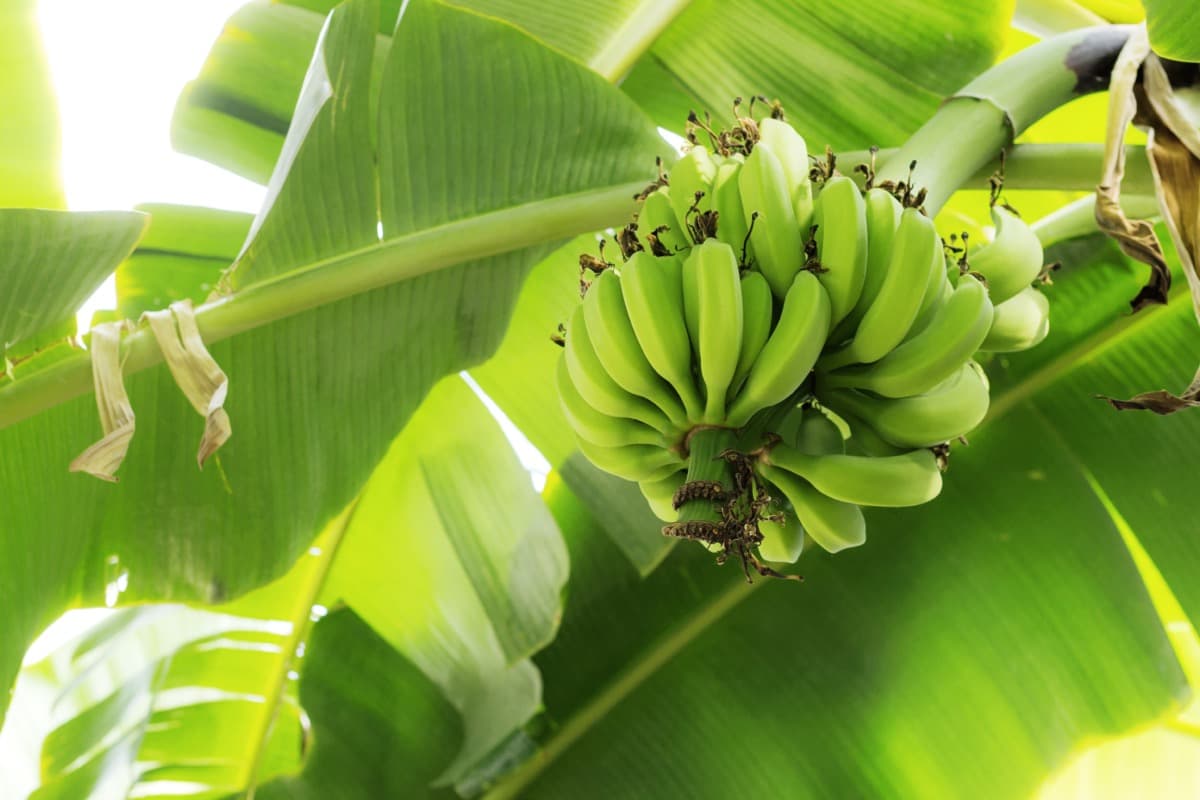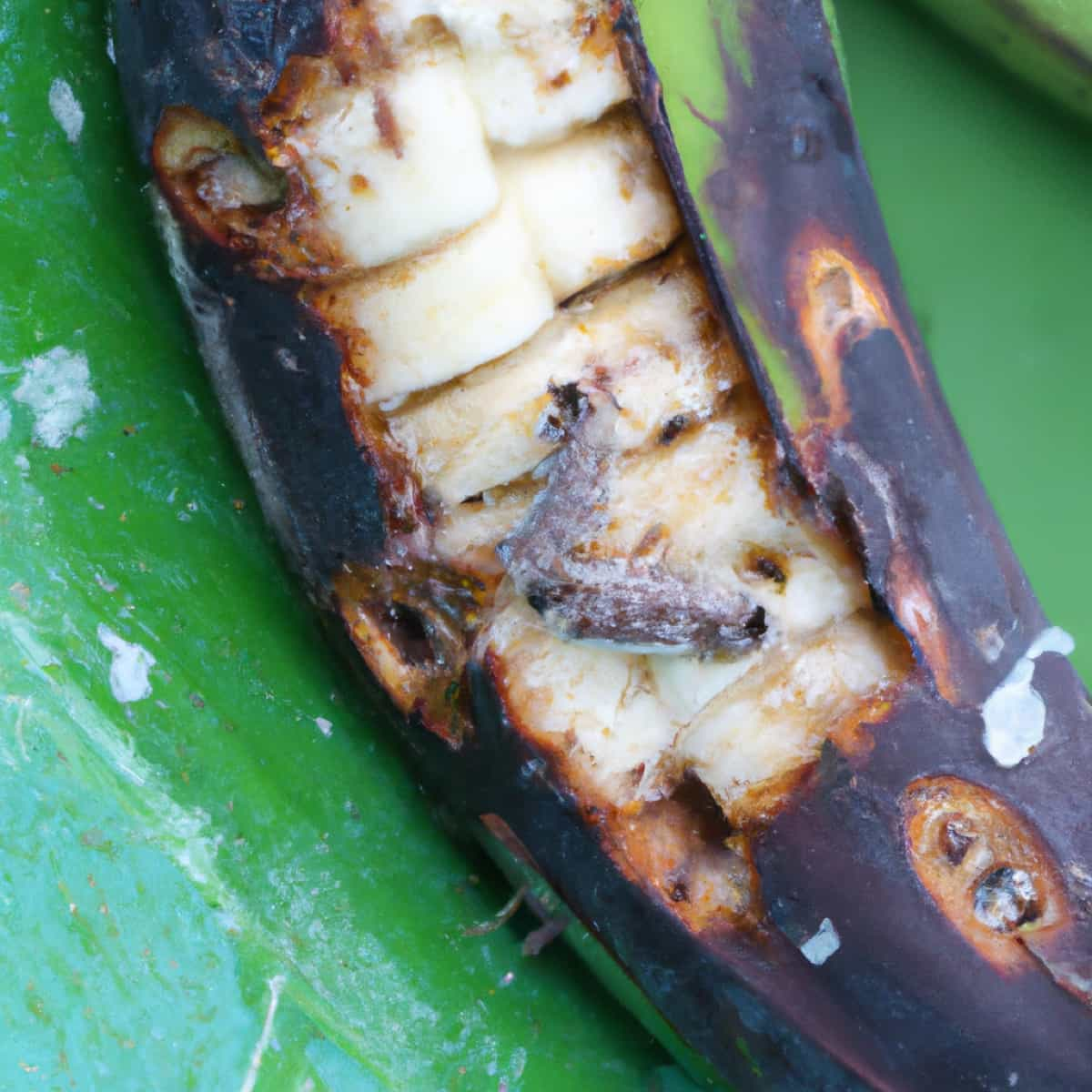The Banana Cutworm Pest, Spodoptera litura, belonging to the Family Noctuidae of the Order Lepidoptera, is a polyphagous and nocturnal insect pest of banana crops that feed on the leaves, buds, and fruits of banana plants, causing significant yield losses and reducing the quality of the fruit. The Banana Cutworm is native to Asia. It can also transmit viral and bacterial diseases to banana plants. This pest is particularly problematic in areas with high humidity and temperature.

Addressing this pest through sustainable and integrated pest management strategies is crucial to ensure the sustainability of banana farming and food security worldwide. To effectively manage this pest, it is important to understand its life cycle, its preferred habitats, and the best methods for controlling it. This article will provide an overview and discussion of the Banana Cutworm Pest in Banana crops, including its symptoms, identification techniques, and control.
Banana Cutworm Pest Management
Life Cycle of Banana Cutworm Pest in Banana Crop
The lifecycle begins when the female lays her eggs on the lower side of the leaves of banana plants. The eggs hatch in about 2-3 days, depending on the temperature and humidity. The eggs can be laid in batches of up to 200 eggs, and the female can lay up to 1,500 eggs in her lifetime. The larvae of the Banana Cutworm are the most damaging stage of the pest’s lifecycle. They hatch from the eggs and immediately start feeding on the leaves and fruits of the banana plant. The larvae of the Banana Cutworm pass through several instars or growth stages before pupating.
The larvae feed at night and hide during the day, making detecting and controlling their population challenging. The larvae grow in about 10-20 days, depending on the temperature and food availability. After the larvae have grown, they pupate by spinning a silk and plant debris cocoon. The pupal stage lasts 5-10 days, after which the adult emerges. The adults are active at night and mate soon after emerging from the pupal stage. The entire lifecycle can be completed in 30-50 days.
Occurrence of Banana Cutworm Pest in Banana Crop
- Location of Banana Cutworm pest: This pest infests Banana crops in India, Africa, Sri Lanka, China, Thailand, Indonesia, the United States, Mexico, Brazil, Colombia, Ecuador, the Philippines, and Australia.
- Host range: The Banana Cutworm is a polyphagous pest that infects crops like Banana, Groundnut, Citrus, Soybean, Cotton, Castor, Maize, Pulses, Peppers, Millets, Safflower, Cabbage, Tomato, Sweet potato, Bhendi, and Chilli.
Factors Favoring the Population Increase of Banana Cutworm Pest in Banana Crop
- The pest thrives in warm temperatures, and the optimal temperature range for its growth and development is 20-30 °C. In areas with high temperatures, the pest can complete its lifecycle faster.
- The pest prefers high moisture levels in the soil and air. Areas with high rainfall and humidity levels are more prone to infestation by this pest. In areas where the pest is prevalent, planting during the rainy season can increase the risk of infestation.
- Overcrowding banana plants can create a favorable microclimate for the pest, leading to higher infestation levels.
- The presence of alternative hosts for the pest can also increase the risk of infestation in banana crops.
- Poor sanitation practices, such as leaving crop debris on the ground, can create ideal conditions for the pest.
Identification of Banana Cutworm Pest in Banana Crop
- Egg: The eggs are round, flat, and light green.
- Larva: The larvae are greenish-brown, with a lighter underside and dark stripes running along their backs. They can grow up to 40mm long and have a cylindrical body.
- Pupa: The pupa is dark brown and around 15-20mm long.
- Adult: The adult Banana Cutworm is a moth with a wingspan of around 30-40mm. The adult is mottled brown and gray, with a distinctive white spot on each forewing.
In case you missed it: Banana Leaf Feeder Pest Management: Symptoms, Treatment, Chemical, Biological, and Organic Control

Damage Symptoms of Banana Cutworm Pest in Banana Crop
- The larvae feed gregariously on the epidermal layers of the leaves and skeletonize them.
- In the severe stage, only the stem and branches will stand in the field without leaves.
- Once inflorescence develops, they prefer the flowers to the leaves and bore into them completely.
- The feeding is seen only in the early morning and at night.
- They will hide in the inflorescence or the crevices of the soil during hot sunny hours of the day.
- The larvae of the Banana Cutworm can cause significant damage to the crops by feeding on the young leaves and fruits, leading to stunted growth, reduced yield, and poor-quality fruits.
Percentage of Yield Loss in Bananas Due to Banana Cutworm Pest
- In India, the yield losses due to Banana Cutworm pests are 20-50%. In Thailand, the percentage of yield loss is 10-50%. In Thailand, it is 5-30%. In Sri Lanka, the losses are 10-50%. In Indonesia, the losses are 5-25%. In Africa, it is 10-70%. In the United States, it is 5-10%. In Mexico, it is 10-30%. In Brazil, it is 10-50%. In China, it is 10-30%.
- In Colombia, the losses are 10-40%. In Ecuador, it is 5-25%. In Australia, it is 5-10%. In the Philippines, the yield losses are 10-50%. The Economic Threshold Level (ETL) for the Banana Cutworm pest is 1 to 2 larvae per plant.
Cultural Control of Banana Cutworm Pest in Banana Crop
- The rotation of banana crops with other crops, such as maize or beans, breaks the pest’s life cycle and reduces its population.
- Perform summer plowing to expose the pupae to scorching sunlight.
- After harvest, collect and destroy eggs, caterpillars, and any plant debris or infested parts. This will help to eliminate overwintering sites for the pest.
- Mulching involves covering the soil around the banana plants with organic material. This helps to improve soil health and reduce the population of pests.
- Proper pruning and thinning of banana plants can improve air circulation and reduce the humidity in the canopy, which can help reduce pest infestations.
- Use light and pheromone traps to monitor, attract and kill adult pests.
Biological Control of Banana Cutworm Pest in Banana Crop
- Predators such as ants, spiders, and beetles, and Parasitoids such as Trichogramma, wasps, and flies can be conserved or introduced into the banana plantation to control the pest.
- Parasitoids, such as Telenomus spodopterae and Telenomus remus, feed on the pest’s eggs.
- The entomo-pathogenic fungus Nomuraea rileyi infects and kills the pest.
- In severe stages, apply the microbial pesticide Bacillus thuringiensis is toxic to the pest.
Chemical Control of Banana Cutworm Pest in Banana Crop
- Spray insecticides on the crops like Avanthe, Azinphosethyl, Imidacloprid, Dichlorvos, Nuclear Polyhedrosis Virus, or Chlorpyrifos on the foliage to control the pest.
- Fumigation – This uses toxic gases like Methyl Bromide and Phosphine to kill pests.
Organic Control of Banana Cutworm Pest in Banana Crop
- Plant extracts from neem, lantana, garlic, cinnamon, ginger, turmeric, and chili can be applied to manage the infestation.
- Bait pellets made of Jaggery, Rice bran, Carbaryl, and Water can be broadcasted in the field during the evening to kill the pests.
Preventive Measures for Control of Banana Cutworm Pest in Banana Crop
- Proper spacing of banana plants can help to reduce the risk of infestation by the Banana Cutworm.
- Castor is an attractive cover crop to the pest and is planted around the corners to lure them away from the main crop.
- Avoid planting during the rainy season, as this is a period when the pest population is high.
- Planting disease-free and pest-free planting material can prevent pest incidence.
- Monitor the crops regularly using pheromone traps to identify pest infestation in the early stages to keep it under control.
In case you missed it: Banana Rust Thrips Pest Management: Symptoms, Treatment, Chemical, Biological, and Organic Control

Conclusion
The Banana Cutworm Pest, Spodoptera litura, is a major pest of banana crops worldwide, causing damage and yield losses. The pest has a wide range of hosts and can cause damage at different stages of the crop’s growth. Integrated Pest Management strategies can be effectively implemented to manage the pest and reduce their impact on banana crops while minimizing the negative impact on the environment and human health.
- Deworming Schedule for Dogs/Puppies: A Beginners Guide
- How to Prevent and Control Parasites in Goats
- Beneficial Insects in Pest Management
- Natural Solutions for Pest Control in Flower Gardens
- Types of Fungicides Used in Agriculture
- Common Issues in the Fruit Development Stage of Pomegranate Farming
- Fruit Development Issues in Papaya: Easy Solutions and Treatment
- Soil-Borne Diseases and How to Protect Your Plants
- Practices to Prevent Disease Spread in the Garden